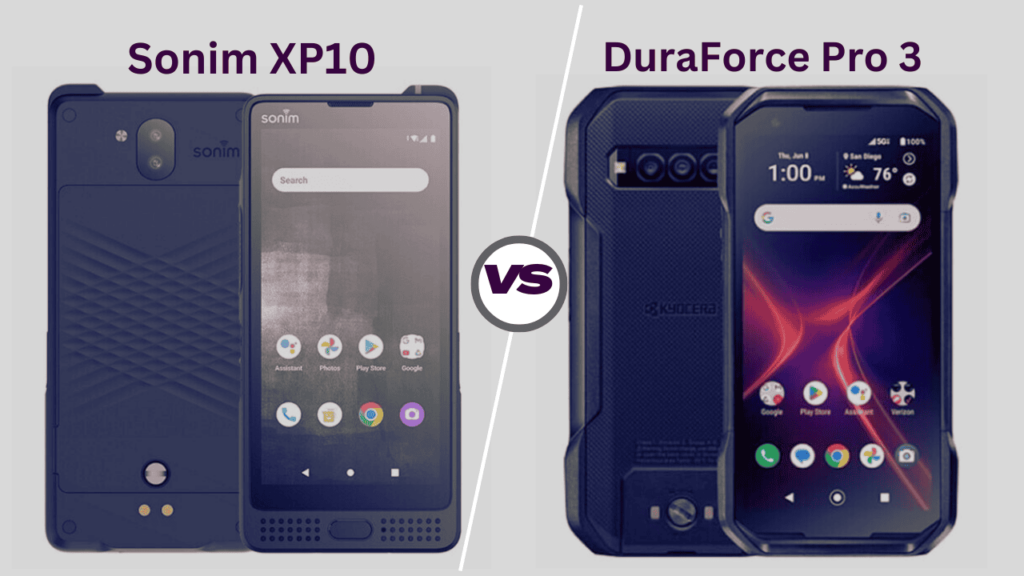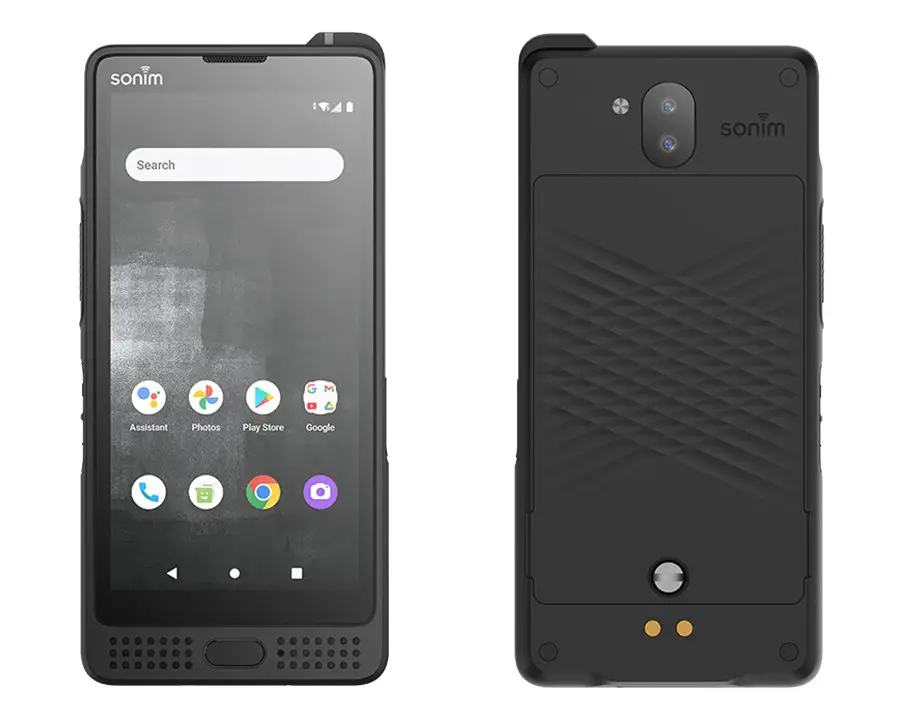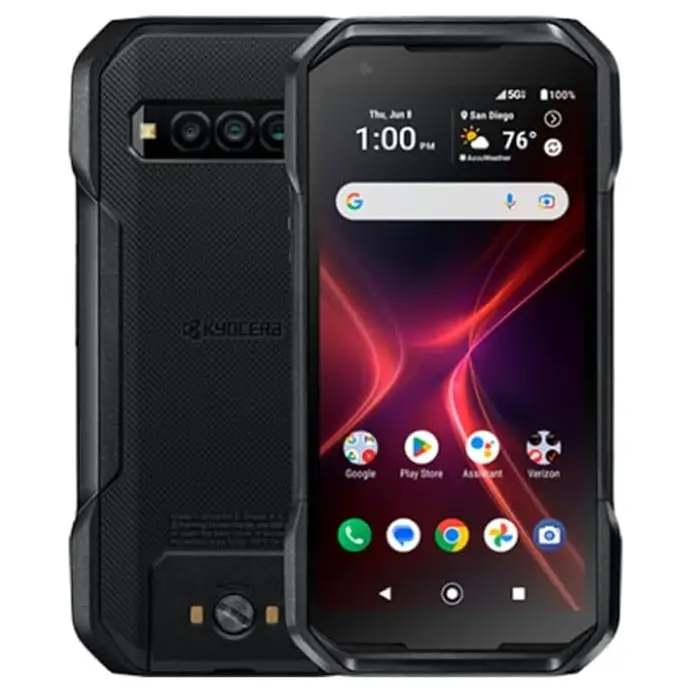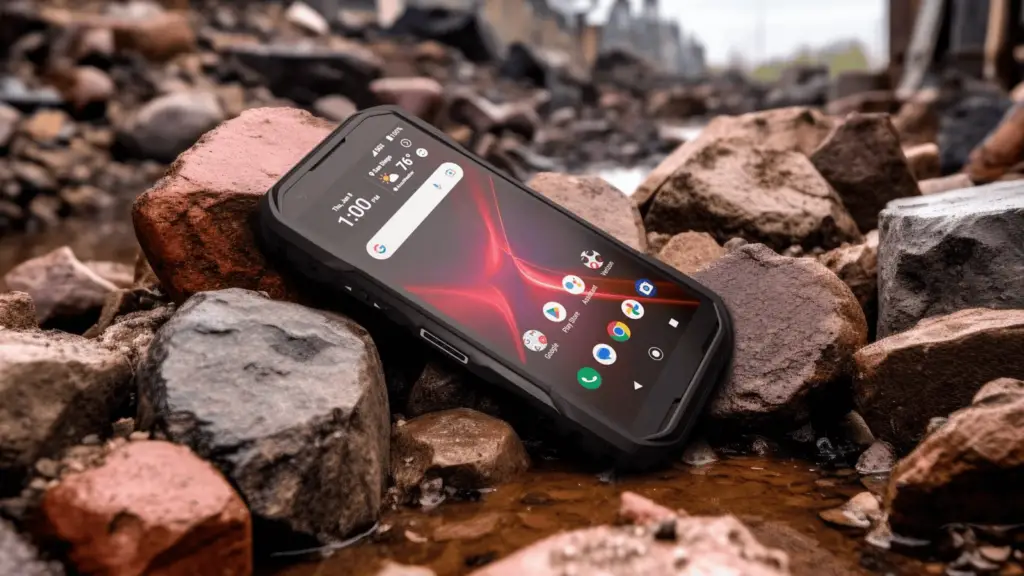Sonim XP10 5G vs. Kyocera DuraForce Pro 3: Which is the Better Rugged Smartphone?

If you are in North America and you are searching for a rugged smartphone that can be used in extreme weather conditions and has top-of-the-line performance, you may have come across the Sonim XP10 5G or the Kyocera DuraForce Pro 3 during your search. Both of these devices are designed to endure tough environments and are suitable for professionals who work in demanding fields like construction, outdoor adventures, or emergency services.
The Sonim XP10 5G is the obvious older model of the two since it has been around since October of 2022. On the other hand, the Kyocera DuraForce Pro 3 is the newer model since it arrived in July of last year (2023). Also, the two devices are priced differently! As of writing, the Sonim XP10 costs $569 on AT&T, while the Kyocera DuraForce Pro 3 is priced at $899 on Verizon, a difference of above $300.
That brings us to the question: which of these devices is right for you, and where should you invest your money? This is the question we aim to answer in this comparison article. We'll look at the key differences and similarities between these two rugged smartphones to help you determine which best fits your needs, beginning with a side-by-side specifications comparison.
Key Specifications Comparison Table:
| Feature | Sonim XP10 5G | Kyocera DuraForce Pro 3 |
|---|---|---|
| Launch Date | October 2022 | July 2023 |
| Operating System | Android 12 (Sonim OS) | Android 14 |
| Chipset | Qualcomm Snapdragon 480 5G (8 nm) | Qualcomm Snapdragon 7 Gen 1 (4 nm) |
| CPU | Octa-core (2x2.0 GHz & 6x1.8 GHz) | Octa-core (1x2.4 GHz, 3x2.36 GHz & 4x1.8 GHz) |
| Display | 5.5-inch IPS LCD, 1080 x 2160 pixels | 5.38-inch OLED, 1080 x 2160 pixels |
| RAM | 6GB | 6GB (LPDDR4x) |
| Storage | 128GB, expandable up to 1TB | 128GB (UFS 2.2), expandable up to 1TB |
| Rear Camera | Dual: 50MP + 8MP | Triple: 64MP + 16MP + 2MP |
| Front Camera | 8MP | 8MP |
| Battery | 5000mAh, removable | 4270mAh, removable, 27W Quick Charge |
| Ruggedness | MIL-STD-810H, IP68, IPX9K, ATEX/IECEx | MIL-STD-810H, IPX5, IPX8, IP6X |
| Dimensions (Weight) | 161 x 77.5 x 16.4 mm (320 grams) | 154 x 75 x 14.5 mm (237 grams) |
| Network Compatibility | 2G, 3G, 4G, 5G | 2G, 3G, 4G, 5G, mmWave |
| Fast Wired and (Wireless) Charging | No stated (Yes) | 27W (Yes (Qi, 8.1W)) |
| Special Features | Dual front 100dB loudspeaker, PTT | Dual front-facing speakers, Haz-Loc |

Sonim XP10 5G vs. Kyocera DuraForce Pro 3: Comparison Summary
Design and Build Quality
Sonim XP10 5G:
The Sonim XP10 5G is built with military-grade durability, adhering to MIL-STD-810H standards. This means it’s capable of withstanding shocks, drops, and extreme temperatures ranging from -40°F to 140°F. The phone is also rated IP68 and IPX9K, making it resistant to dust, water, and high-pressure sprays. It can be submerged in water for up to 30 minutes without sustaining damage.
As for the physical dimensions, the XP10 5G measures 161 × 77.5 × 16.4 mm and weighs a hefty 320 grams. Its design is bulkier, reflecting its focus on durability over sleekness in most modern smartphones. Additionally, the Sonim XP10 is ATEX/IECEx Zone 2/22 certified, making it usable in an area where "an explosive atmosphere is not likely to occur in normal operation". For more details about ATEX/IECEx Zone classifications, please see this article.
Kyocera DuraForce Pro 3:
Moving to the Kyocera DuraForce Pro 3, it also meets MIL-STD-810H standards and offers an IP68 rating for dust and water resistance. It’s certified to survive drops from up to 2 meters and can withstand temperature ranges from -20°C to +60°C.
The DuraForce Pro 3 is slightly more compact at 154.0 x 75.0 x 14.5 mm and lighter at 237 grams. Its design is rugged yet somewhat more refined, making it easier to carry while still offering significant protection.
Verdicts: While 320 grams is not out of the industry standard for a rugged smartphone, the Kyocera's offer of 237 grams should appeal better to those who prefer a lighter device. However, if you work in an industry that demands a certain level of ATEX or IECEx Zone ratings, the Sonim XP10 is the better option.
Display
Sonim XP10 5G:
The Sonim XP10 5G features a 5.5-inch IPS LCD screen with a resolution of 1080 x 2160 pixels. The display is protected by Corning Gorilla Glass Victus, providing excellent scratch and impact resistance. The screen is designed for visibility in bright conditions, which is essential for outdoor use.
Kyocera DuraForce Pro 3:
The DuraForce Pro 3 on the other hand has a slightly smaller 5.38-inch OLED display with the same resolution of 1080 x 2160 pixels. Like the Sonim, this display is also protected by Corning Gorilla Glass Victus for better durability.
Verdicts: OLED technology typically offers better contrast and deeper blacks compared to IPS. This makes it superior for media consumption, giving the DuraForce an edge over the XP10.

Performance
Do you remember the price difference mentioned in the introduction? The majority of that difference lies in this section
Sonim XP10 5G:
Starting with the Sonim XP10, it is powered by the Qualcomm Snapdragon 480 5G chipset. This chipset includes an octa-core processor with two high-performance Cortex-A76 cores running at 2.2 GHz and six power-efficient Cortex-A55 cores at 1.9 GHz. It’s a reliable 8nm mid-range processor that supports 5G connectivity and was launched back in January 2021.
The phone comes with 6GB of RAM and 128GB of internal storage, which can be expanded up to 1TB via a microSD card. How about the DuraForce Pro 3?
Kyocera DuraForce Pro 3:
As for the Kyocera DuraForce Pro 3, it is equipped with a more advanced Qualcomm Snapdragon 7 Gen 1 chipset that was announced in May of 2022. This 4nm processor offers a significant performance boost with an octa-core setup that includes a high-performance Cortex-A710 core running at 2.4 GHz, three additional Cortex-A710 cores at 2.36 GHz, and four Cortex-A510 cores at 1.8 GHz. The inclusion of the Adreno 644 GPU also means better graphics performance.
Similar to the Sonim XP10, it has 6GB of RAM and 128GB of internal storage, expandable via an SD card up to 1TB. However, it utilizes UFS 2.2 storage technology, which is faster than the standard storage in the XP10 5G.
Verdicts: The DuraForce Pro 3 from Kyocera is the clear winner here due to the CPU. The Chipset has an Antutu score that is more than twice that on the XP10 (average 673511 vs 289177). This is one of the reasons why the DuraForce Pro 3 is much more expensive than the XP10. For comparison sake, Kyocera also has another smartphone with a Snapdragon 480 CPU. It is called the DuraSport 5G. That model is priced around $579, but the XP 10 is built more robust and a better option than the DuraSport 5G.
Camera
Sonim XP10 5G:
The Sonim XP10 5G features a dual rear camera setup, including a 50MP main sensor and an 8MP ultrawide sensor. This combination is capable of taking decent photos, especially for a rugged phone. It also has an 8MP front camera for selfies and video calls.
Kyocera DuraForce Pro 3:
The DuraForce Pro 3 on the other hand offers a more versatile triple camera setup. It includes a 64MP main sensor, a 16MP ultrawide lens, and a 2MP depth sensor, making it better suited for a variety of photographic scenarios. The 8MP front camera is on par with the XP10 5G.
Verdicts: Both phones have a nice camera setup enough for rugged phones, but the rear camera setup on the DuraForce Pro 3 is more advanced, allowing for more detailed and dynamic photography. It can even record 4K and 1080p videos at both 30 and 60fps which is a great option for professionals who want to capture their works with crystal clear eyes.
Battery Life
Sonim XP10 5G:
Moving to the battery segment, the XP10 5G is equipped with a large 5000mAh battery that provides up to 30 hours of talk time or 500 hours of standby time. This battery is removable, making it easier to replace if needed, and the phone supports wireless charging as well.
Kyocera DuraForce Pro 3:
On the DuraForce Pro 3 is a slightly smaller 4270mAh battery, but it should still offer good endurance thanks to the efficiency of the Snapdragon 7 Gen 1 chipset. It supports 27W Quick Charge and 8.1W wireless charging for faster recharging times compared to the XP10 5G.
Verdicts: I will be giving this section to the DuraForce Pro 3, not because of its endurance rating, but because of its faster-charging technology. 27W fast charge could help refill your device faster for more adventures. Endurance rating on the other hand dependent on how well the OS is optimized.
Connectivity and Other Features
Sonim XP10 5G:
The Sonim XP10 5G supports 5G connectivity and comes with various communication options including Bluetooth 5.1, Wi-Fi, and USB Type-C. It has a dual SIM setup, but it’s not clear if the second SIM operates in standby mode.
Additional features include a secure audio connector, Push-to-Talk (PTT) key, and dual front-facing speakers with 100dB output. It also includes a variety of sensors like a fingerprint scanner, accelerometer, proximity sensor, and more.
Kyocera DuraForce Pro 3:
The DuraForce Pro 3 also supports 5G and includes a more advanced set of connectivity options such as NFC, Bluetooth 5.2, Wi-Fi 6/6E, and USB Type-C 3.2. It supports eSIM (Nano-SIM + eSIM), giving it more flexibility for managing networks.
It is equipped with dual front-facing speakers, Haz-Loc support, and Push-to-Talk functionality. The device also features advanced GPS navigation with dual-band GPS and more comprehensive sensor support.
Verdict: Both phones come with advanced connectivity options. But the DuraForce Pro 3 has the edge because it is a more recent device, meaning updated connectivity technologies over the XP10
Software
Sonim XP10 5G:
The Sonim XP10 5G runs on Android 12 with Sonim’s custom OS layered on top. While it provides a clean user interface and the necessary rugged features, it’s two versions behind the competitor's offer.
Kyocera DuraForce Pro 3:
On the other hand, the Kyocera DuraForce Pro 3 runs on Android 14 out of the box, offering the latest software features and updates. This ensures better performance, security, and access to the newest Android features.
Verdicts: The recent DuraForce Pro 3 with Android 14 is better than the XP10's Android 12

Conclusion
Both the Sonim XP10 5G and Kyocera DuraForce Pro 3 are engineered to thrive in the most challenging environments, but they cater to slightly different needs depending on your priorities. Choosing between duos depends largely on your specific needs. If you prioritize extreme durability with ATEX/IECEx Zone zone rating in mind, the Sonim XP10 5G might be the better option for you.
However, if you’re looking for a more modern device and processor with advanced camera capabilities, and the latest Android experience, the Kyocera DuraForce Pro 3 stands out as the more well-rounded choice. Both devices are exceptional in their ruggedness, but the Kyocera DuraForce Pro 3 edges out slightly due to its more advanced hardware and software offerings.
Final verdicts: If budget is not a constraint, go with the DuraForce Pro 3 from Kyocera. But if you wish to save money for some good accessories like rugged water-resistant earbuds, the XP10 from Sonim is much more than enough for a rugged smartphone. Then you can invest the extra $300 on getting other rugged accessories for a more rounded outdoor setup.

Leave a Reply